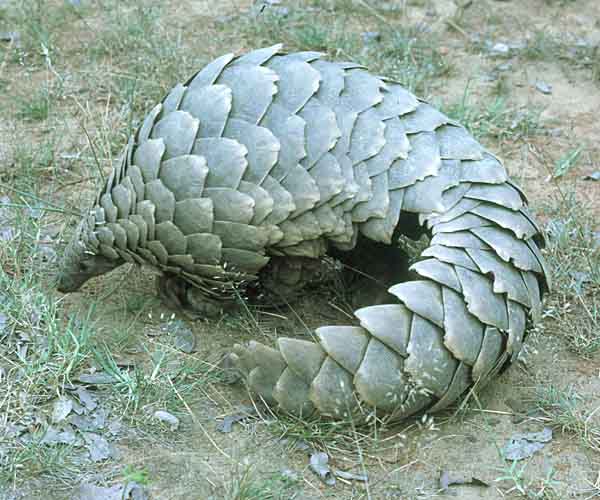
Ground pangolin, or Temminck's pangolin, or The cape pangolin (Manis temminckii)
Phylum —chordata
Class — mammalia
Order — pholidota
Family — manidae
Genus – manis
Appearance
Pangolins are almost completely covered in overlapping, protective scales, which makes up about 20% of their body weight. The scales are composed of keratin, the same material that forms human hair and fingernails, and give pangolins an appearance similar to a pinecone or artichoke. The underside of a pangolin is not covered with scales, but sparse fur, instead. When threatened, it usually rolls up into a ball, thus protecting its vulnerable belly.
Pangolins are 30 to 90 cm (1 to 3 feet) long exclusive of the tail and weigh from 5 to 27 kg (10 to 60 pounds). Mature adults are light brown, olive, and dark brown in color, while young are pale brown or pink in color.
Habitat
The Ground pangolin lives in southern and eastern Africa, from Sudan and north-eastern Chad to South Africa.
Behavior
The Ground pangolin is solitary and nocturnal, although in winter often it will venture out during the late afternoon. It spends most of its time on the ground, though it is able to climb and can swim well. It normally walks slowly, with its head swaying and its tail dragging on the ground, although it can run and walk on two legs. Ground pangolins are able to dig their own burrows but they prefer to live in those dug by spring hares or anteaters, and sleep curled up in them. Little is known about how they communicate with each other, but they probably use visual cues, smells, sounds, and touch.
Diet
Ground pangolins are carnivores (insectivores), they eat mainly termites and ants, and occasionally larvae or other soft-bodied insects.
Reproduction
Ground pangolins are polygynous, males fighting fiercely for access to a female. Breeding occurs throughout the year, even while females are rearing young. Gestation is for about 139 days, and usually one young is born. Births take place in an underground shelter. The babies are carried outside once they reach 2 to 4 weeks old. A pup will stay with its mother for around 3 months, and may accompany its father for an extra month, though this is rare. Then it becomes completely independent, but remains in its mother's home range until it is about one year old. Females probably breed once they are 3-4 years old and males probably reach maturity around the same age, but may not breed until they are 5-7 years old.
Lifespan is about 12 years.
In captivity
They are easily tamed and they are not a danger to humans. Because pangolins don't even have teeth, they don't bite, and they wouldn't do it even if they had teeth. Despite their large claws, pangolins don't even try to scratch a human.
When keeping a pangolin, you should take into account its habit of digging. Large claws can cause significant damage to your home. For this reason, it is best to keep the pangolin in an aviary. The enclosure should be spacious, with constant access to clean water. Water must be changed every day. The air temperature should be 25-30°C. At temperatures below 25°C, pangolins usually start to shake. This is a sure sign that he may catch a cold.
At first, if the pangolin has not got used to you yet, it may get scared. At the same time, it curls up into a ball. Leave it alone for a while, it will turn itself around. If you insist, it can spray a stinking stream of liquid. Over time, it will get used to you and stop curling up.
It is very important to choose the right food for the pangolin. In captivity, it is difficult to organize a daily delivery of 500 g of ants. You can give mealworms and other insects, but not always. Long-term feeding of these insects can lead to disease and even death of the pangolin, since ordinary insects and their larvae are too fat for it. It is best to feed the pangolin with special feed mixtures intended just for such animals, for example, "Mazuri". Some breeders give anteaters dry (not fat) chicken meat and chicken eggs, pre-crushed, and abundantly sprinkled with calcium. You can give non-fat milk from time to time. Be sure to give a lot of minerals (especially calcium) and vitamins (especially vitamin D3). It is better to add calcium to food. You can give it in the form of calcium gluconate, which is sold in all pharmacies. Vitamins can also be purchased at a regular pet store. In a moderate climate, in the summer it is necessary to walk pangolins in the forest or park where there are anthills. In the enclosure of the pangolin, it is necessary to place a container with small stones (pebbles) not far from the feeder. Pangolins swallow them while feeding. This is necessary for proper digestion.
 Russian
Russian
 English
English
























